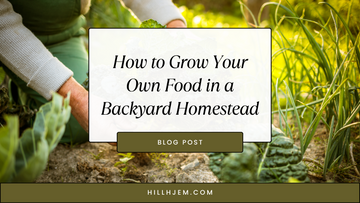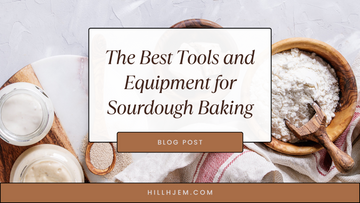
Have you ever dreamt of biting into a juicy, homegrown tomato bursting with flavor? Or snipping fresh herbs for your dinner straight from your backyard?
If so, then this guide is your roadmap to cultivating a thriving backyard homestead. We'll walk you through everything, from getting started to picking your delicious harvest. Get ready to enjoy fresh food, feel good about growing your own, and have some fun in the backyard! Let's dig in!
Why Grow Your Own Food?
1. Fresher, More Nutritious Produce
Homegrown vegetables are picked at their peak ripeness, resulting in superior flavor and a higher concentration of vitamins, minerals, and antioxidants compared to store-bought produce that may have traveled long distances and sat on shelves for days.
2. Save Money on Groceries
Growing your own vegetables translates to significant savings on your grocery shopping. Fresh, organic produce can be expensive, and by cultivating your favorites at home, you can free up your budget for other needs.
3. Connection to Nature
Stepping outside to care for your garden provides a welcome respite from the daily grind. Immersing yourself in nature reduces stress, improves mood, and fosters a deeper appreciation for the environment.
4. Self-Sufficiency and Empowerment
Knowing that you can nurture and harvest your own food cultivates a sense of self-reliance and accomplishment. It empowers you to take control of your food source and provides a feeling of security.
5. Learning Experience
Gardening is a lifelong learning journey. You'll gain valuable knowledge about plant life cycles, soil health, and sustainable practices. This knowledge can be passed down to future generations, fostering a love for nature and a connection to the origins of our food.
First Step: Planning Your Backyard Bounty
Before enthusiastically digging into the soil, take a step back and assess your space. Consider these key factors:
- Sunlight
Most vegetables require at least 6-8 hours of direct sunlight daily. Observe your yard throughout the day to identify the sunniest spots.
- Space
Even tiny balconies can accommodate container gardens. Raised beds are space-efficient solutions for yards with limited square footage.
- Soil Quality
Rich, well-drained soil is essential for healthy plant growth. Conduct a simple soil test to determine your soil type and amend it accordingly with compost or organic matter.
Second Step: Choosing The Right Crops
Here's a roadmap to guide you on how to choose the crops to grow:
- Climate
Research vegetables that thrive in your specific climate zone. This information is readily available online or at your local nursery.
- Seasonality
Plan your plantings based on your growing season. Cool-season crops like lettuce and spinach flourish in spring and fall, while heat-loving tomatoes and peppers prefer summer's warmth. Consider incorporating some cool-season crops under shade cloth during the hotter months.
- Personal Preferences
Grow what you love to eat! Prioritize vegetables your family regularly consumes. Don't be afraid to experiment with a few interesting heirloom varieties for an extra culinary adventure.
Third Step: Planting (Seeds or Seedlings?)
There are two main approaches to starting your edible garden:
- Seeds
This cost-effective method offers a wider variety of choices. Seeds are sown directly outdoors when the danger of frost has passed for warm-season crops. Cool-season vegetables can be started indoors a few weeks before transplanting them outside.
- Seedlings
Purchasing young plants from a nursery jumpstarts your harvest and is ideal for impatient gardeners or those with short growing seasons.
Fourth Step: Nurturing Your Garden
Once your seeds or seedlings are nestled in their new home, provide them with the care they need to flourish:
- Watering
Consistent watering is crucial, especially during dry spells. Aim for deep watering at the base of the plant, allowing the soil to dry slightly between waterings.
- Weeding
Regular weeding prevents unwanted competition for water and nutrients. Hand-pulling weeds is a therapeutic (and free!) way to maintain your garden.
- Feeding
Amend your soil with compost or organic fertilizer throughout the growing season to replenish nutrients and encourage healthy plant growth.
Fifth Step: Harvesting the Rewards of Your Labor
The moment of truth arrives! Here's what you need to know about harvesting:
- Ripeness:
Pick vegetables at their peak ripeness for optimal flavor and quality. This varies depending on the specific crop variety.
- Harvest Regularly
Frequent harvesting encourages continued plant growth and production.
- Storage
Research proper storage methods for your harvested vegetables to extend their shelf life. Root vegetables often keep well in cool, dark storage areas, while leafy greens may last a few days in the refrigerator.
Last Step: Preserving Your Harvest Bounty
If you find yourself with a surplus of garden goodness, explore preservation techniques to enjoy your homegrown favorites throughout the year:
- Canning
This method involves sterilizing food in airtight jars to prevent spoilage. It's ideal for preserving fruits, vegetables, and even jams and jellies. Check out our guide to canning here.
- Freezing
Blanching vegetables and freezing them is a quick and simple way to preserve their freshness for later consumption.
- Drying
Sun-drying or dehydrating herbs is a fantastic way to concentrate their flavors for year-round use in cooking.
Growing your own food is a rewarding and enriching experience. It fosters a deeper appreciation for nature's bounty, teaches valuable life skills, and connects you to the cycle of life and the joy of self-sufficiency.
Ready to Get Your Hands Dirty?
With a little planning, dedication, and the knowledge gleaned from this guide, you can transform your outdoor space into a thriving haven that nourishes your body and soul. Remember, the most important ingredient for a successful garden is a sprinkle of passion and a whole lot of love for the magic of growing your own food. Happy planting!




